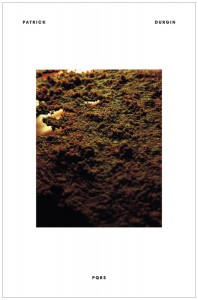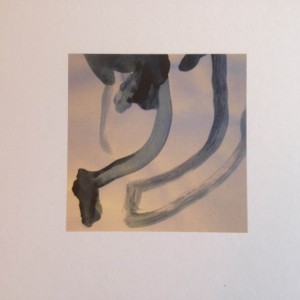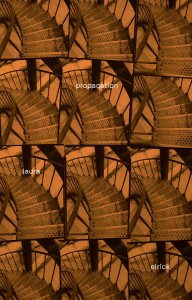Patrick Durgin’s PQRS
 PQRS
PQRS
by Patrick Durgin
Kenning Editions, Feb 2013
80 pages / $12.95 Buy from SPD or Kenning Editions
If poets theater is first and foremost “about the scene of its production,” as Kevin Killian and David Brazil claim in their intro to the new Kenning Anthology of Poets Theater, what is contemporary poet’s theatre “about?” Patrick Durgin’s PQRS, the audience becomes the company charged with producing the writer’s script. Casting the steadfastly oblique dialogue tasks the imagination, but the ample, winding stage directions provide a topology. Reading the text could be compared to hitting a salad bar with the smartest people you know–a justifiable decision for an evening, though filled with silent chewing and self-effacing questions. In this way, PQRS proves both informative and tiresome, upbuilding and desolate, all at once. The title names both the four players of the script, and a government incentive program which allows physicians to recoup part of their Medicaid payments by the timely submission of quality reports to a central agency. As a publishing house, Kenning has been hoarding infectious manuscripts; Laura Elrick’s Propagation is a parasitic worm that undermines the sense of rhythmic continuity in the ear and eye, and the germ of critique transmitted in PQRS inflames doubt around the positivist psychological organism most humanisms revere. Durgin’s players grope through the dissolution of soliloquy and turn essay in on itself through a fallacious argument for pornography. Much in the way that ancient drama was a mirror held to the polis, poet’s theater can be an instrument of self-reflection for a coterie of writers and artists to have a view onto their current historical assemblage. If this is the only goal of PQRS, which would be enough to ask, then Durgin provides us with a full serving of our current end-of-days squabbling, financial hi-jinx, and artistic quietude. The book is adorned with photos of meat, on the front, the cut is obscured into an eerily lifeless landscape, and on the back, fluttering, unfocused bacon. The book’s motion mimics the replication of DNA, or the motion of Hegel’s dialectic, a strange but life-sustaining pattern for a play that abjures dramatic structure. Act One and Two oppose each other, with S overcoming Q &R’s sidebar, and the metaphysical interlude between Acts Two and Three becomes the fulcrum–and the transformational moment–around which opposed modes of communication crumble, leaving again a ground. That interlude of intimacy between writer and reader comes free of staging and soothes the screeching moments when the players of the script make attempts at dialogue.

At the opening of Act One, Scene One, S, who shares a heritage but not temperament with her co-stars, creates a snug, rectangular enclosure by rolling out neutral linens onto the stage. In the striking book of portraits Daughter, images from childhood inhabit a similarly inscribed space. Part of S‘s role in the play is to speak of, about and on behalf of essay as a genre [as opposed to say, metaphysics]. “It should be possible to enjoy a commanding view of [X]… but numerous renditions, beheadings, dismemberments, and coats of paint have compromised the historical continuity of this perspective, or rather problematized its plausibility” is a weak skepticism, and points the reader to the probability that some of what is happening is lost on us. Not an unfamiliar feeling in the land of instantaneousness. It seems one of the premises of the Durgin’s play is the inevitability of one’s keeping of a ‘commanding’ view of the new regimes and regimens of production, commanding in the sense that, like the LCD screen, a view has a logic and reproducibility which circumscribes the user’s actionable possibilities. One only does away with such a view at the behest of society, and the ‘poeté maudit’ tradition may be informing the implosion of form that the user of this book will sense in the periphery.

I choose the word user because one detectable context for the play is the coterie of users, and if you are reading this, you are likely instantiated more in user-hood than in the population of human bodies. Daughter is heavily indebted to this mode of thinking as well, as the photographs of sticker-book collages are cropped and wrought in yellowed tones that mimic Instagram’s manufactured nostalgia. The flip-side of these photographs are snapshots of pre-literate scribbling, evidence of the nascent self-reflective impulse “to write.” Presumably all credit goes to his infant daughter there. The timeline of the composition of PQRS stretches from the late nineties dotcom bubble to the jarring present. The book is deliberately assembled, though perhaps frantically and mindlessly written at times. S opens Scene Two by opening a laptop which gives a tinny version of the enveloping music from the previous scene, and an email appears as the book’s only moment of soliloquy, when it is disclosed how parts of the production were composed. The concepts underlying the production process seem to be ones that the regime of the user has ushered in: wiki-composition, textual mashups, transparency, tumblr. But the text here doesn’t obtain mastery of execution, but rather a kind of energizing interference by its pursuit of those ephemeral objects.
Durgin, who is the founder of Kenning Editions, is like the franchise owner and the star player at once, and to a larger audience this could seem a conflict of interest, the suspicion doesn’t amount to much, in fact, it makes PQRS a more emboldened, decisive book. One might even deflect the accusation and point to a scene in Act Two which is a ‘wiki’ of hypothetical performance art pieces, from Shanghai to Vienna to the Twin Cities, all submitted by other assistant professors. This part of the book may intrigues by its method, and yet is the most resistant to the page, and needs the dressing of research to be supported by the average imagination. To continue the salad bar analogy, this scene is the one large bowl in the middle holding the standard house mix: romaine, iceberg, bleeding cherry tomato, Sol Lewitt, minced cucumber, more romaine, and art-house cinema. It’s the bowl that everybody reaches for in order to get good plate coverage, but whose only real function is to keep digestion “regular.” Other scenes do provide the intelligent critical moments and savory metaphysical propositions. The additional scenes are not meant for as a main course; they are toppings which provide a technique of characterizing each eater/actor/professor, only after they have padded the plate with the proverbial ‘meat’ of the salad bar enclosure. Finish with croutons, watercress, and foreign travels. The blurbs call the book “a monumental failure” and “a world whose very conceptual difficulty supplies a context for new models of dramatic form and provides a vehicle for the kinds of thinking and representing that happen when various avant-garde ideologies collide with the twin crises of postmodern irony and capitalist recuperation,” but I maintain that it is a salad bar, probably one of anti-capitalist practices for the user generation. In being this, it utterly succeeds, providing a commanding view onto the landscape of discursive and technological obstacles resistance will confront during the decades we face presently.

At the end of the first act, S responds to Q’s recited mashup of Rimbaud and a news article on US dollar hegemony by counterposing the didactic lyric poem and the essay, a binary which epistemologically eviscerates her. Unironically, Durgin allows her to toe the line between mystic idealism and crude materialism, the shitty first marriage of the intensive and the extensive [the psychological and the physical]. The user of the text confronts an interrupting realization: when reading “to stay informed” and “for pleasure” are two sides of the same coin, what other drives can a reading practice attempt to satisfy? If one cannot choose misery, attempting to recognize the open failure of the essay and the soliloquy, to which all user-interaction may boil down, becomes a kind of spiritual exercise. For all the genre-centered hand-wringing that the press is offering, PQRS is still a book, a heavily regulated and easily apprehended object, though if the writings inside are dense enough resist intelligibility. But the consuming project of the Kenning imprint is starting to come into sight with this release, alongside Daughter and the anthology of poet’s theatre. The audience for PQRS is somewhat implicated in the failure to sustain a responsive, self-modulating theater to replace the death-mongering meritocracy of the civilization, and this might be dissatisfying for some. But the recent works of Kenning, taken together, are starting to resemble the opening lines of a broader spiritual gesture, reminiscent of the forging of cadres done by Stein, Duncan, Olson, and the New York School. Durgin just happens to be the curator now, versifying a terrible renewed fortune for the sea of users-to-come.
***
C.J. Morello is a poet with a B.A. in Philosophy from UChicago and an M.A. in Writing from UC–Davis. His writing is forthcoming in Gigantic, and tweets come forth @siegethethird
October 28th, 2013 / 11:00 am
Propagation by Laura Elrick
 Propagation
Propagation
by Laura Elrick
Kenning Editions, Dec 2012
106 pages / $14.95 Buy from Amazon or SPD
The poems in Propagation might seem quiet at first, or early on in the book, consisting mostly of simple phrases restated again and again with different line breaks, subtle emphasis shifting in language we might otherwise overlook, and while that might be true in some cases, don’t be fooled: these poems are loud shouts and angry jokes, raucous and just as ready to hit you as to be read. And this is a good thing during a manufactured crisis in poetry having to do with affect and identity and stuff you already know about if you’re all conversant with what’s going on in the poetry teacup right now.
What’s great is that all that stuff is beside the point. Delivered in a deadpan lateral slide that manages to recall both Gertrude Stein and Larry Eigner, Propagation is a defiant book, ready to just provide you with language you’ve taken for granted and let you figure it out. Again, this is a very, very good thing. Propagation doesn’t so much present with you with poetry to appreciate or interpret as it presents you with words and phrases cut mostly like chunks off vernacular language and just offered, take it or leave it, life for example the following excerpt from an untitled poem:
this is really
thanks thanks
this is
this is
really this
is thanks
I’m
thanks and you
and you
and you
and you
thanks
this is
thanks
and you
So what’s above is both devoid of content and overdriven with it: devoid because we as readers don’t “get anywhere” beyond a stutter of I, you, this, and thanks, and overdriven because the more insistent the excerpt gets at connecting “you” and “thanks” the more sinister it seems, as if the thanks might be forced or insincere or desperate or all three. Many of the poems here work like this: what seems wan gets pounded home with great force until something as ephemeral as a thank you lands in a constantly shifting territory between and I and a you that don’t need to be named or described because it’s not them that matter it’s the gesture trapped in the stammer.
And as deft as Elrick is with empty generalities, she’s just as good with the kind of local and particular that you might be looking for in a “normal” poem, as in the following excerpt:
bio fuel
cardmoms want
to know why this svelt pixie
is cutting the floor to pieces
why you approach on impulse
asking why
she danced with two knives in the hallway
circling her intensity and anguish
which has something to do with Tecumseh (?)
vaguely but it does why
this girl is stabbing her kidney
do you want
the highest stiletto
no
the best speech
wicked smartness
want the schooling
(you said you did in the application)
September 9th, 2013 / 11:05 am
No Matter of Insistence
 Left Having
Left Having
by Jesse Seldess
Kenning Editions, 2011
112 pages / $14.95 Buy from Kenning Editions or SPD Books
Jesse Seldess’s work asks for time. It doesn’t demand time, it just gently requests it. A space to sit with it, a time to read it aloud, to perform it yourself in your own voice and body.
In his two books—Who Opens and Left Having (both from Kenning Editions)—Seldess writes short echoing, transmogrifying lines, separated often by large spaces on the page. The poetry is formed out of these minimal bits and their steady repetition: lines that subtly alter as they repeat in various forms over the course of the pages.
If I let the ending continue
If I left impending continue
If I left the end to you
We can meet in this place
Previous to seeing his books, I’d heard Seldess reading his poetry in a recording on Pennsound. I was blown away by the slowness, the paused rhythm, the continual stops. It felt daring to stand up and read in this glacial way, and yet his voice was so unassuming about his slowness. At the end of one reading, he says, “Thanks for your patience.” It’s an endearing experimentalism, an quietly apologetic foray into a different kind of poem. I like the playful timidity of his work, his awareness of the space it takes up in the world. An antithesis of (and antidote to) avant-garde bravado.
In all of Seldess’s work is an attention to the spaces between: “Incompletely binding // Little things / With.” This hanging preposition signals the silence that often serves as a super-structure for his work. In his readings, Seldess carefully matches the length of his silences to the size of the spaces between lines and stanzas on the page.
This very concrete relationship between page and performance appears to be one of Seldess’s central concerns: from 2000 until 2012, Seldess published antennae, a journal of experimental writing and language-based music and performance scores. (Issues 1-7 are available as free pdf downloads. Issues 9-12 are available for purchase. Issue 8 seems to be in limbo.) When work is so intensely aural, the page begins to function as a score for performance.
In one of his readings on Pennsound, Seldess says of his first book, Who Opens: “all the pieces in the mansucript in some way are concerned with the issues and dynamics of formation, sort of an awe, wonder, and appreciation of it, and at the same time a fear and skepticism of it, ranging through that spectrum.” I felt this powerfully in both of the books: an attention to how words build or fail to build, to how the mind is able or unable to form something out of words.
Some of the poems in Seldess’s first book emerged out of his work in social services with the elderly, specifically with those affected by dementia and Alzheimers. This awareness of the mind and its failures is powerfully present: all the time thinking about contact: “To be close // Near that mouth / From here instance.”
January 21st, 2013 / 12:00 pm
